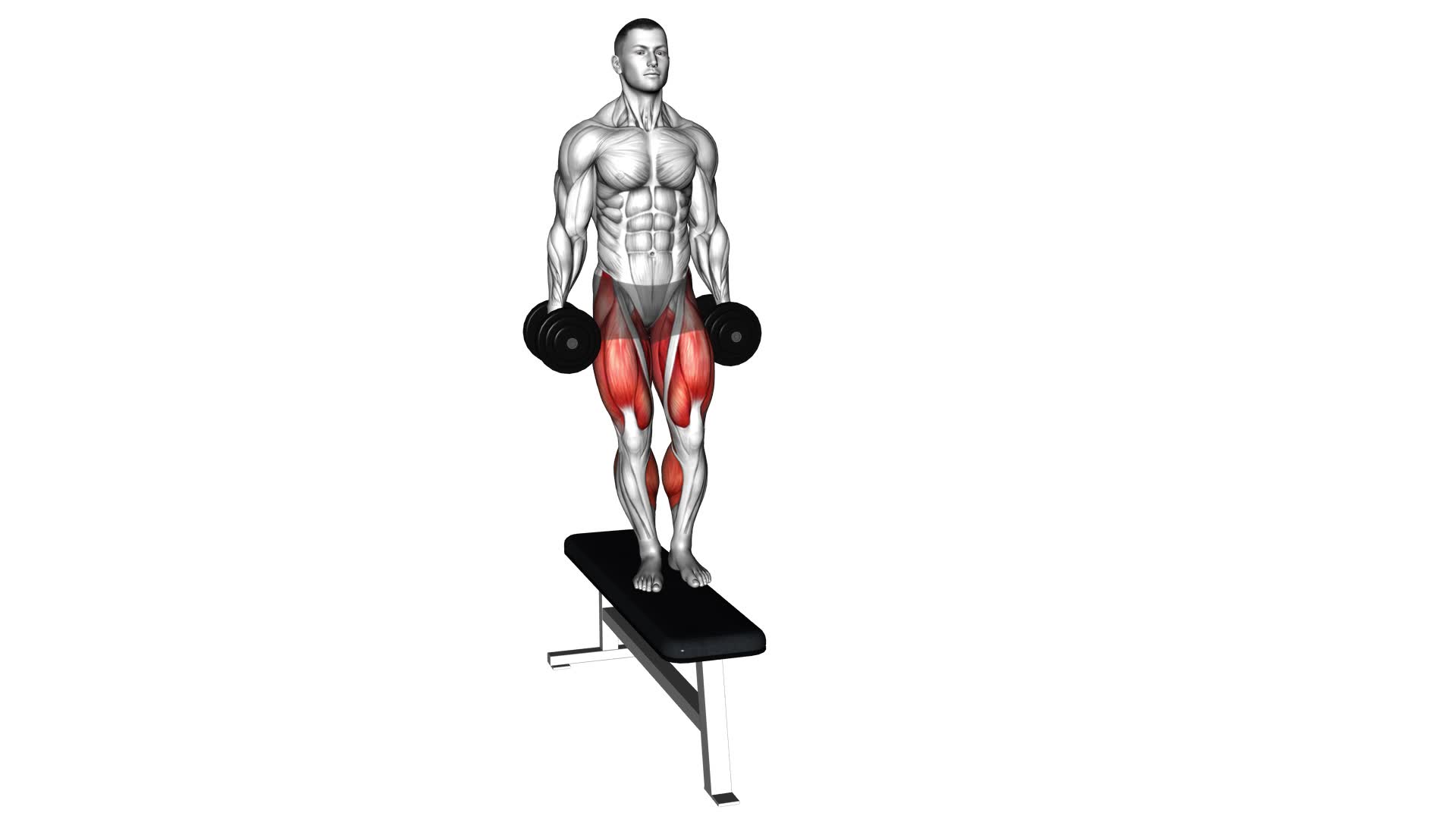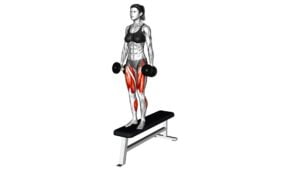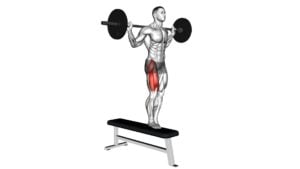Dumbbell Lateral Step-up (male) – Video Exercise Guide & Tips

Looking to build strength and tone your lower body? The dumbbell lateral step-up is a great exercise for you.
Watch This Exercise Video
In this video exercise guide, we'll show you the proper form and technique, as well as provide tips to maximize your results.
Don't worry, we've got you covered with a sample workout routine too.
Get ready to step up your fitness game with this challenging yet effective exercise.
Let's get started!
Key Takeaways
- The dumbbell lateral step-up is highly effective for muscle activation and cardiovascular endurance.
- It engages leg muscles including quadriceps, hamstrings, and glutes, leading to improved strength and tone in the lower body.
- Adding weight or resistance to the exercise enhances strength and power gains, balance and stability, and promotes muscle growth.
- When adding weight, it is important to start with lighter weights and gradually increase load to reduce the risk of injury and ensure proper form.
Benefits of the Dumbbell Lateral Step-up
You can experience several benefits from including the Dumbbell Lateral Step-up in your workout routine. This exercise is highly effective for muscle activation and cardiovascular endurance.
When performing the Dumbbell Lateral Step-up, your leg muscles, including the quadriceps, hamstrings, and glutes, are engaged to lift your body weight and the dumbbells. This results in increased muscle activation, leading to improved strength and tone in your lower body. Additionally, the lateral movement involved in this exercise helps to target the muscles of the inner and outer thighs, promoting better balance and stability.
In terms of cardiovascular endurance, the Dumbbell Lateral Step-up is a dynamic exercise that gets your heart rate up. By incorporating this exercise into your routine, you can enhance your cardiovascular fitness and stamina.
The combination of muscle activation and cardiovascular endurance makes the Dumbbell Lateral Step-up an efficient and effective exercise for overall fitness.
To ensure you get the most out of this exercise, it's important to maintain proper form and technique. By following the correct form, you can maximize the benefits and prevent injuries.
Proper Form and Technique
To maintain proper form and technique for the Dumbbell Lateral Step-up, focus on engaging your core and keeping your movements controlled and precise. This exercise targets your glutes, quads, and hamstrings, so it's important to execute it correctly to maximize its effectiveness.
One common error to avoid is leaning too far forward or backward during the movement. This can put unnecessary strain on your lower back and compromise your form. Instead, keep your torso upright and maintain a slight forward lean from your hips.
Another mistake is using too much momentum. Remember to control the movement throughout, especially when stepping up and down. This will ensure that your muscles are fully engaged and working hard.
To progress the exercise, you can increase the weight of the dumbbells you're using. Start with a weight that challenges you but allows you to maintain proper form. As you become stronger and more comfortable, gradually increase the weight to continue challenging your muscles.
Additionally, you can increase the height of the step or add an unstable surface, such as a balance pad or Bosu ball, to further engage your stabilizer muscles.
Variation: Adding Weight or Resistance
To maximize the benefits of the dumbbell lateral step-up exercise, you can add weight or resistance. By adding weight, such as holding dumbbells or wearing a weighted vest, you increase the challenge for your muscles and enhance strength and power gains.
It's important to maintain proper form and technique when adding weight, ensuring that your knees stay aligned with your toes and that you engage your glutes and hamstrings throughout the movement.
Additionally, be sure to start with a weight that's appropriate for your fitness level and gradually increase as you become stronger to prevent injury.
Benefits of Adding Resistance
By incorporating added weight or resistance into your dumbbell lateral step-up routine, you can maximize the benefits of this exercise. Adding resistance provides several advantages and is of great importance when it comes to achieving your fitness goals.
Firstly, it increases the intensity of the exercise, challenging your muscles and promoting strength gains. The added resistance forces your muscles to work harder, leading to increased muscle activation and growth.
Secondly, it helps improve your balance and stability by requiring more control and coordination during the exercise. This is particularly beneficial for athletes and individuals looking to enhance their athletic performance.
Lastly, adding resistance creates a progressive overload, which is essential for continued progress and preventing plateaus in your training.
Proper Form With Weight
How can you properly add weight or resistance to your dumbbell lateral step-up routine?
When incorporating weight or resistance into your workout, it's crucial to maintain proper form to ensure maximum effectiveness and minimize the risk of injury.
Start by choosing an appropriate weight or resistance level that challenges you without compromising your technique.
Hold the dumbbells in each hand or use a resistance band around your hips for added resistance.
As you perform the lateral step-up, focus on keeping your core engaged, your back straight, and your knees in line with your toes.
Avoid using momentum and instead, rely on the strength of your muscles to lift your body.
Safety Precautions When Adding Weight
When adding weight or resistance to your dumbbell lateral step-up routine, it's important to take safety precautions to prevent injuries and ensure effective results.
Common injuries to watch out for include strains or sprains in the knees, ankles, or lower back. To avoid these injuries, it's crucial to start with lighter weights and gradually increase the load as your strength and stability improve. This allows your muscles and joints to adapt to the added stress and reduces the risk of overexertion.
Starting with lighter weights also helps you maintain proper form and technique, which is essential for targeting the intended muscles and maximizing the benefits of the exercise.
Common Mistakes to Avoid
To maximize your results and prevent injury, it's important to be aware of common mistakes to avoid while performing the dumbbell lateral step-up exercise. Here are some technique tips to help you get the most out of your workout:
- Using too much weight: One common mistake is using weights that are too heavy. This can lead to poor form and increase the risk of injury. Start with lighter weights and gradually increase as you become more comfortable with the exercise.
- Leaning forward or backward: Another mistake is leaning too far forward or backward during the exercise. This can put unnecessary strain on your back and decrease the effectiveness of the exercise. Keep your torso upright and engage your core for stability.
- Neglecting proper foot placement: Proper foot placement is crucial for maintaining balance and stability. Make sure your entire foot is on the step and avoid letting your heel hang off the edge. This will help you maintain control throughout the movement.
By avoiding these common mistakes, you can ensure that you're performing the dumbbell lateral step-up exercise correctly and effectively. Remember to start with lighter weights, maintain an upright torso, and place your feet properly on the step.
Happy stepping!
Tips for Maximizing Results
To maximize your results, focus on proper form and consistently challenge yourself with heavier weights during the dumbbell lateral step-up exercise.
Proper form is crucial for targeting the right muscles and avoiding injuries. Make sure to keep your back straight, engage your core, and step onto the platform with your whole foot. Avoid leaning forward or using momentum to lift the weight.
As you progress, it's important to increase the intensity of your workout by gradually adding more weight. This will challenge your muscles and stimulate growth. However, it's important to listen to your body and only increase weight when you feel comfortable and confident in your form.
For advanced modifications, you can try incorporating different variations of the dumbbell lateral step-up exercise. You can increase the height of the platform, use resistance bands for added resistance, or perform the exercise explosively by jumping onto the platform. These modifications will further challenge your muscles and increase the overall intensity of your workout. However, it's important to master the basic form before attempting these advanced variations.
By focusing on proper form, consistently challenging yourself with heavier weights, and incorporating advanced modifications, you can maximize the results of your dumbbell lateral step-up exercise.
Now let's move on to the next section, where we'll provide you with a sample workout routine with the dumbbell lateral step-up.
Sample Workout Routine With Dumbbell Lateral Step-Up
Let's discuss the main points of the sample workout routine with dumbbell lateral step-up.
Firstly, this exercise targets multiple muscle groups including the glutes, quadriceps, and hamstrings, making it an effective lower body workout.
Additionally, there's a variation that beginners can try, which involves using lighter dumbbells or no weights at all to gradually build strength and stability.
Muscle Groups Targeted
Engage your lower body muscles with the Dumbbell Lateral Step-Up exercise. This exercise primarily targets your quadriceps, glutes, and hamstrings, helping you build strength and stability in your lower body.
Here's what you need to know about the muscle activation and exercise modifications for this workout:
- Quadriceps: The primary muscle group activated during the Dumbbell Lateral Step-Up is the quadriceps. These muscles, located on the front of your thighs, help extend your knees as you step up onto the platform.
- Glutes: Your glutes, the muscles in your buttocks, are also heavily engaged during this exercise. They work to stabilize your hips and help you maintain balance throughout the movement.
- Hamstrings: The hamstrings, located on the back of your thighs, act as stabilizers during the Dumbbell Lateral Step-Up. They assist in knee flexion and hip extension.
Now that you understand the muscle groups targeted in this exercise, let's move on to exploring some variations for beginners.
Variation for Beginners
In the article titled 'Dumbbell Lateral Step-up (male) – Video Exercise Guide & Tips {617812}', let's now dive into a variation for beginners when incorporating the Dumbbell Lateral Step-Up into your workout routine.
If you're new to this exercise, it's important to start with beginner modifications to ensure proper form and prevent injuries. To make it easier, you can perform the step-ups without any dumbbells initially. Instead, focus on mastering the movement and maintaining balance.
As you progress, you can gradually add light dumbbells to increase the intensity. Another progression for beginners is to decrease the height of the step. Start with a lower platform and gradually work your way up as your strength and confidence improve.
Remember to always listen to your body and adjust the difficulty level accordingly.
Frequently Asked Questions
How Many Calories Does the Dumbbell Lateral Step-Up Exercise Burn?
The dumbbell lateral step-up exercise is a great way to burn calories and improve your balance. By incorporating dumbbells into this exercise, you can increase the intensity and calorie burn.
The lateral step-up targets your glutes, quads, and hamstrings, helping you build strength and tone your lower body. As you step up onto the platform, your muscles work to stabilize your body, improving your balance and coordination.
Can the Dumbbell Lateral Step-Up Exercise Help Improve Balance?
The dumbbell lateral step-up exercise is a great way to improve your balance. By incorporating dumbbell lateral step-up variations into your workout routine, you can challenge your stability and strengthen your lower body muscles.
This exercise requires you to step up onto a raised platform while holding dumbbells, engaging your core and improving your coordination.
The benefits of incorporating this exercise into your routine include increased leg strength, improved balance, and enhanced overall stability.
Is the Dumbbell Lateral Step-Up Exercise Suitable for Beginners?
The dumbbell lateral step-up exercise can be suitable for beginners, but it's important to start with modifications if needed.
Focus on maintaining proper form and balance throughout the movement.
As you become more comfortable, you can progress by increasing the weight of the dumbbells or adding more repetitions.
Remember to listen to your body and gradually challenge yourself to avoid injury.
Proper technique and gradual progression are key to getting the most out of this exercise.
What Muscles Does the Dumbbell Lateral Step-Up Primarily Target?
The dumbbell lateral step-up primarily targets several muscles in your body. It works your glutes, quads, and hamstrings, helping to strengthen and tone your lower body. By incorporating dumbbell lateral step up variations into your workout routine, you can enhance stability, improve balance, and increase overall leg strength.
This exercise also engages your core muscles, promoting better posture and stability. So, if you're looking for an effective lower body exercise, the dumbbell lateral step-up is a great choice.
How Often Should the Dumbbell Lateral Step-Up Exercise Be Performed for Optimal Results?
To achieve optimal results, it's important to consider the frequency of the dumbbell lateral step-up exercise.
Incorporating this exercise into your workout routine two to three times a week can be beneficial.
By performing the dumbbell lateral step-up regularly, you can target various muscles such as the quadriceps, glutes, and hamstrings.
This exercise also helps improve balance, stability, and overall lower body strength.
Remember to start with a weight that challenges you but allows for proper form.
Conclusion
In conclusion, the dumbbell lateral step-up is an effective exercise that targets the lower body muscles, particularly the glutes, quads, and hamstrings. By adding weight or resistance, you can further challenge your muscles and increase strength.
It's important to maintain proper form and technique to avoid common mistakes and maximize results. Incorporating the dumbbell lateral step-up into your workout routine can help improve leg strength, stability, and overall fitness.

Author
Years ago, the spark of my life’s passion ignited in my mind the moment I stepped into the local gym for the first time. The inaugural bead of perspiration, the initial endeavor, the very first surge of endorphins, and a sense of pride that washed over me post-workout marked the beginning of my deep-seated interest in strength sports, fitness, and sports nutrition. This very curiosity blossomed rapidly into a profound fascination, propelling me to earn a Master’s degree in Physical Education from the Academy of Physical Education in Krakow, followed by a Sports Manager diploma from the Jagiellonian University. My journey of growth led me to gain more specialized qualifications, such as being a certified personal trainer with a focus on sports dietetics, a lifeguard, and an instructor for wellness and corrective gymnastics. Theoretical knowledge paired seamlessly with practical experience, reinforcing my belief that the transformation of individuals under my guidance was also a reflection of my personal growth. This belief holds true even today. Each day, I strive to push the boundaries and explore new realms. These realms gently elevate me to greater heights. The unique combination of passion for my field and the continuous quest for growth fuels my drive to break new ground.







